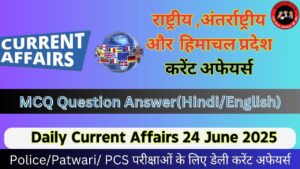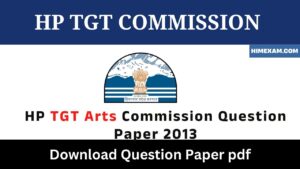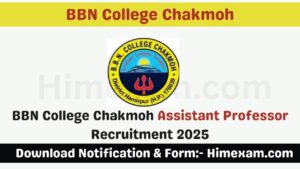Important Indian History Question Answer In English Set-4
||Important Indian History Question Answer In English Set-4||Important Indian History Question Answer for hpssc/hpsssb Set-4||
31. Who were the first kings to issue gold coins in India?
(A) Mauryas
(B) Indo-Greeks
(C) Guptas
(D) Kushans
Explanation:-The Indo-Greek kings were the first to issue gold coins in India and their coins were special in the sense that each king had his own distinctive coins by which he could be definitely identified. The names of at least thirty Bactrian kings are known with the help of numerous coins, and they help in the reconstruction of the history of the kings. The coins carry legends in Greek and also in Kharosthi and Brahmi
32. Where is Brihadeshwar Temple situated ?
(A) Kanchi
(B) Madurai
(C) Shri Shailan
(D) Tanjore
Explanation:-The Brihadeshwar Temple at Thanjavur (Tanjore) in the Indian state of Tamil Nadu, is a Hindu temple dedicated to Shiva and a brilliant example of the major heights achieved by Cholas in Tamil architecture. It is a tribute and a reflection of the power of its patron Raja Raja Chola I. It remains India’s largest temple and is one of the greatest glories of Indian architecture. The temple is part of the UNESCO World Heritage Site “Great Living Chola Temples”
33. In Tamil literature the glorious books ‘Shilppadikaram and Manimekhalai’ are related to
(A) Jainism
(B) Buddhism
(C) Hindusim
(D) Christianity
Explanation:-Shilppadikaram is one of the five Great Epics according to later Tamil literary tradition, the others being Manimegalai, Civaka Cintamani, Valayapathi and Kundalakesi. The poet prince Ilango Adigal is credited with this work. He is reputed to be the brother of Senguttuvan from Chera dynasty. Ilango Adigal was a Buddhist monk and Silappadhikaram and Manimekalai are Buddhist epics. Manimekalai, a purely Buddhist work of the 3rd Sangam period in Tamil literature is the most supreme and famous among the Buddhist work done in Tamil. It is a work expounding the doctrines and propagating the values of Buddhism.It also talks about the Tamil Buddhists in the island
34. Who established Mahabalipuram?
(A) Pallava
(B) Pandya
(C) Chola
(D) Chalukya
Explanation:-Mahabalipuram, derived from ‘Mamallapuram’ is the prior and colloquial name of a town in Kancheepuram district in the Indian state of Tamil Nadu, now officially called Mamallapuram. Mahabalipuram was a 7th century port city of the South Indian dynasty of the Pallavas near the city of Chennai in Tamil Nadu. The name Mamallapuram is believed to have been given after the Pallava king Narasimhavarman I, who took on the epithet Maha-malla (great wrestler), as the favourite sport of the Pallavas was wrestling. It has various historic monuments built largely between the 7th and the 9th centuries, and has been classified as a UNESCO World Heritage Site.
35. The Saka era commencing from A.D. 78, was founded by
(A) Kanishka
(B) Asoka
(C) Chandragupta
(D) Vikramaditya
Explanation:-The date of Kanishka’s accession is disputed, ranging from 78 to 248. The generally accepted date of 78 is also the basis for an era presumably started by the Shakas and used in addition to the Gregorian calendar by the present-day Indian government.
36. Ganhadra school of art came into existence in
(A) Hinayana sect
(B) Mahayana sect
(C) Vaishnava sect
(D) Shaiva sect
Explanation:-The Gandhara school of art is mainly related to Mahayana Buddhism which encouraged image worship. The Kushan kings, particularly Kanishka, encouraged the Gandhara artists. The Gandhara sculptures have been found in the ruins of Taxila and in various ancient sites in Afghanistan and in West Pakistan. They consist mostly of the images of the Buddha and relief sculptures presenting scenes from Buddhist texts. A number of Bodhisattva figures were carved out. A figure of Gandhara shows the first sermon in the deer park and the death of the Buddha. In all these figures there is a realistic treatment of the body although it is draped. In these sculptures there is a tendency to mould the human body in a realistic manner paying great attention to accuracy and physical details particularly in the presentation of muscles, moustaches, etc. Also the representation of the thick bold fold lines forms a distinct characteristic. Thus the Gandhara sculptures offer a striking contrast to what has been discovered elsewhere in India
37. Out of the following remains excavated in Indus Valley, which one indicates the commercial and economic development ?
(A) The Pottery
(B) Seals
(C) The boats
(D) The houses
Explanation:-The seals of the Indus Valley Civilization have been one of the major sources for information about the period. Apart from giving plethora of informations about the social and religious life of the period, they give insight into the economic activities. The economy of the Indus civilization was based on a highly organized agriculture, supplemented by an active commerce, probably connected to that of the ancient civilizations of Mesopotamia. Trade amongst the civilizations is suggested by the finding of hundreds of small seals, supposedly produced by the Indus peoples, at the excavation sites of ancient Mesopotamian cities that were existent around the same time. Some of the seals mention the rulers of different countries.
38. Who, according to the Buddhists, is believed to be the next incarnation of Gautam Buddha ?
(A) Atreya
(B) Maitreya
(C) Nagarjuna
(D) Kalki
Explanation:-Maitreya is foretold as a future Buddha of this world in Buddhist eschatology. In some Buddhist literature, such as the Amitabha Sutra and the Lotus Sutra, he or she is referred to as Ajita Bodhisattva. Maitreya is a bodhisattva who in the Buddhist tradition is to appear on Earth, achieve complete enlightenment, and teach the pure dharma. According to scriptures, Maitreya will be a successor of the historic Sakyamuni Buddha
39. Who among the following were contemporaries of Kanishka ?
(A) Kamban, Banabhatta, Asvagosha
(B) Nagarjuna, Asvagosha, Vasumitra
(C) Asvagosha, Kalidasa, Banabhatta
(D) Kalidasa, Kamban, Va-sumitra
Explanation:-The eminent Buddhist writers Nagarjuna, Asvaghosha, Parsva and Vasumitra flourished at the court of Kanishka. Nagarjuna was the great exponent of Mahayana doctrine and Asvaghosha, a multifaceted personality, was known as a poet, musician, scholar and zealous Buddhist monk. Charaka, the most celebrated authority on Ayurveda was the court physician of Kanishka and Mathara, a politician of rare merit, was his minister. Vasumitra presided over the fourth Buddhist Council.
40. Which rulers built the Ellora temples?
(A) Chalukya
(B) Sunga
(C) Rashtrakuta
(D) Pallava
Explanation:-These religious establishments could have received royal patronage from various dynasties, even though inscriptional evidences are lacking for most of them. The only definite inscriptional evidence is that of Rashtrakuta Dantidurga (c. 753-57 A.D.) The majority of the Brahmanical establishments and the remaining Buddhist ones can be attributed to the Rashtrakuta times which indicate the religious tolerance of the contemporary period. The Jaina caves definitely postdate the Rashtrakutas as indicated by the style of execution and fragmentary inscriptions. This region was under the control of Kalyani Chalukyas and Yadavas of Deogiri (Daulatabad) during this period.
Join Our Telegram Group :- Himexam









